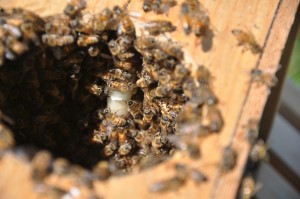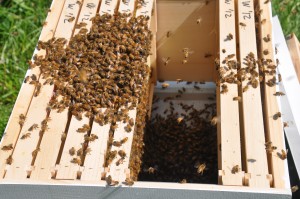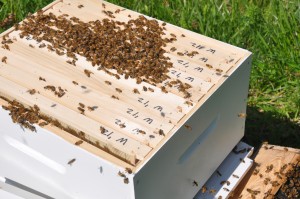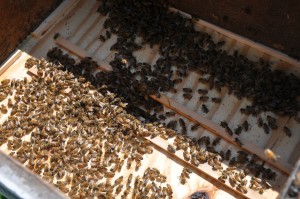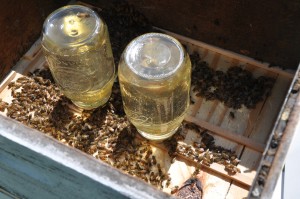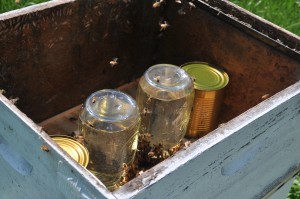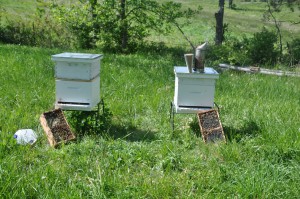Installation of the new packages
On Saturday, April 7th, I picked up two, 3 pound packages of honey bees from The Honey & Bee Connection, in Morehead, Kentucky. I would like to thank Jim Coss, owner and proprietor of The Honey and Bee Connection, for making this series of posts possible by providing the bees and equipment. (For more information on this series see post 1). I arrived home from Morehead late in the day, tired and still suffering from jet lag after my return from Asia, and decided to postpone installation of the new packages until the next day. While it is important to install packages as soon as possible, a one day delay is not a problem, especially since I knew that these bees had been shaken into the packages no earlier than Thursday. If bad weather had ensued, I would not have hesitated to wait even another day to get the packages into hives. Upon arriving home, I placed them in a dry, unheated, but not cold room in my house, where I knew the temperatures would remain in the 50s to low 60s – ideal holding temperatures for the packages. I also dug out a CLEAN spray bottle, filled it with 1:1 sugar syrup (though 2:1 syrup would work as well) and sprayed some on the sides of the screen package. Though each package contains a can of sugar syrup which the bees can access, it is a good idea to supplement this food. But do not spray the package so much that the bees get wet with the syrup. You’ll see the bees stick their proboscises (tongues) through the screen to suck up the syrup. After they have taken an application of syrup, you can spray some more on every few hours or 2-3 times a day as long as you don’t wet the bees down. Other than that, I just left them alone until the next day.
Before installing, some homework for you
There is a lot of good information on package installation in beekeeping books and on the internet. I recommend Dr. Keith Delaplane’s video series Honey Bees and Beekeeping: A Year in the Life of an Apiary. (Go to the Beginning Beekeeping section of this webpage for a link to Dr. Delaplane’s videos and to view the first episode.) This is a great series which will compliment my series of posts. However, the videos were produced more than 15 years ago, and recommendations on disease and parasite control have changed. My posts will contain more up to date information. You will also find that there are variations in the methods used to install packages, but the main point is getting the bees, along with the queen, out of the package, into the hive, and onto the frames.
Installing the packages – before going to the apiary
Mix up ½ gallon of sugar syrup (equal parts by volume of water & sugar) per package of bees to be installed. High fructose corn syrup (HFCS), which you can purchase from beekeeping suppliers, works as well. If you have purchased HFCS, it’s okay to dilute it slightly (add about one quart of clean tap water to a gallon of syrup), but this is not necessary. They’ll take the thicker syrup fine. Apply the syrup as described in the first paragraph.
Nosema disease and fumagillin
You may wish to treat newly installed package bees with fumagillin. Fumagillin is an antibiotic used to control Nosema disease – a disease caused by a microorganism which affects the intestinal tracts of honey bees. Its diagnosis is difficult; the bees often do not show symptoms until they are in serious trouble and accurate diagnosis requires laboratory dissection and examination of a honey bee sample. I do not normally believe in treating for diseases that may not be present, but in the case of Nosema, I think it may head off problems. Any beekeeping professional will give the same advice. Before annual treatment, I suggest collecting samples and sending them to a bee diagnostic lab, but for new packages this may not be practical. The directions for fumagillin can be confusing (measurements are given in milligrams), but just mix one teaspoon of the powder into a gallon of syrup (or ½ teaspoon in ½ gallon of syrup, etc.). Prepare at least one ½ gallon per hive to feed soon after installation. If you’re reading this and are ready to install your bees or have already done so, you can always treat later, or collect a sample of bees later for testing. The USDA Bee Lab in Beltsville, Maryland (see link for information on submitting samples) will provide free testing. Other tips on the medicated syrup: mix it up just before feeding, do not add the powder to hot syrup, and do not use the syrup in entrance feeders (it deteriorates with time, with heat, and in sunlight). I mix the powder with a small quantity of syrup (a cup or so) and then mix that into the full batch. The exception to the necessity of feeding medicated syrup – if the source of your packages tells you that they have tested for Nosema with negative results, or if they treated their colonies with fumagillin, you can skip the treatment.
Gather up all your supplies
Get together any tools you’ll need to install the packages. A pocket knife works well (or a small screwdriver) for removing the corks from wooden queen cages. You’ll also want a hive tool or screwdriver to remove the piece of wood covering the hole in the package bee box. Beginners should light a smoker, and don’t forget your veil and bee gloves. I do suggest that beginners wear gloves even though they’re cumbersome for some aspects of installing a package. You can shed one or both of them for a minute during the actual installation.
Give the screen on the boxes a quick spray with the plain sugar syrup a few minutes before taking the packages out to the bee yard.
To the apiary
Have your hive(s) all set up and your smoker lit. (I’ll do a post soon on lighting a smoker) Don’t forget to take the supplies mentioned above with you.
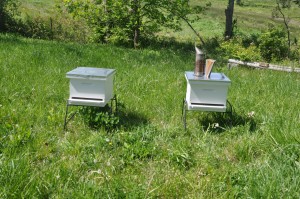
The installation (Remember – this is what works for me, but details can vary. Vital steps are given in italics.)
First, remove the hive lid, inner cover, and about half the frames. Leave the other half to one side in the box. Set the package of bees on top of the remaining frames to give yourself a working surface. I suggest that you whack the shipping package sharply against the hive to knock the bees onto the bottom of the container. Of course, you can ignore this advice if you think it’s mean to the bees, but they are pretty tough. Remove the wooden cover of the package to expose the can of syrup. (Depending on the bee supplier, you may see the queen cage as well.) Remove the can. Easier said than done, I know; it is in there snug.
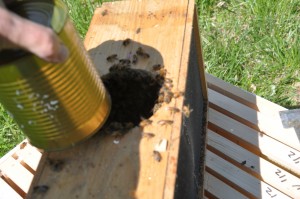
You’ll need to pry up on it with the hive tool or a screwdriver, grasp it, and slide it out. Set the can of syrup aside – the remaining syrup can be used later. Remove the queen cage. You may have taken your gloves off to remove the syrup can, but put them back on to remove the queen cage It will be covered with bees.
This is where the construction of the package box will vary depending on the supplier. Some queen cages are easy to remove – right next to the can. In others, the queen cage is off to the side an inch or two. In one of the packages I installed, the cage had fallen down into the bottom of the shipping package. If it has fallen and you can see it, reach down (with gloves on) and retrieve it. If you cannot see it, proceed to the step of shaking the bees out of the package, let it fall out with the bees, and then pick it up.
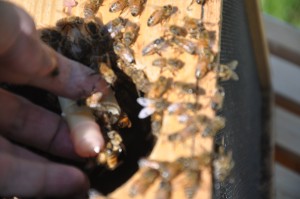
Note: While you’re doing the next step, you may place the wooden cover back over the hole in the shipping package to keep the bees in the package (or not – up to you.)
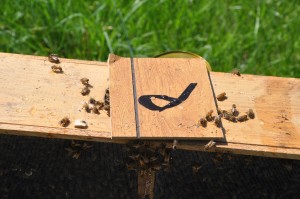
Remove the cork from the queen cage
Remove the cork from the end with the white sugar candy. Never open the non-candy end or directly release the queen into the hive. If the queen cage is plastic, remove the plastic cap. (You’ll see candy under the cap). Never remove any of the candy or poke a hole in the candy with a nail or other implement. (I see these directions given sometimes). The candy is to delay the release of the queen while the bees are acclimating to their new home. Give them all the time they need.
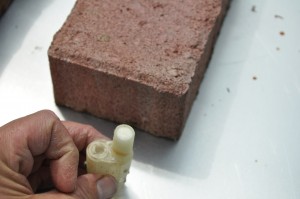
After removing the cap or cork, place the queen cage in the middle of the hive between two frames. On plastic queen cages you can make a hanger (see photo) with a paper clip. Just be careful not impale the queen when you stick the paperclip through the holes of the cage. Some queen cages come with a hanger built in but, if not, you can improvise one. A tack in the end of a wooden queen cage connected to a wire, string, or piece of plastic works well. However, I normally just push two frames together with the queen cage in between, and it stays in place by friction. (All right – sometimes they do fall down to the bottom of the hive).
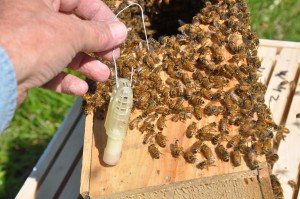
I suggest installing the queen cage with the candy end pointing up. This makes it easier for you to check on how close the bees are to freeing the queen by eating out the candy plug. Also, if the queen cage has attendant bees in it (some do not) and some of the attendants die, they will not fall down and partly block the hole. This time, though, when I put in my queen cages and made hangers with paper clips, I left the candy end down. My queen did not have attendants. Another consideration when installing queen cages: the bees MUST be able to get at the small holes in the cage. They need to make physical contact with the queen and to feed her. There is more than one acceptable way to orient the cage in the hive, but make sure that the bees have access to the queen.
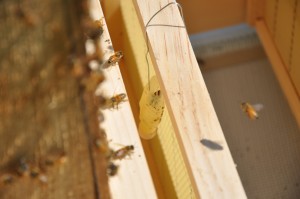
Ten frames
Always start a new hive with ten frames. Some people suggest using just nine in brood boxes. I’ll discuss that in a future post, but for now START your new hive with ten frames. If you start with nine, leaving extra space between the frames, you violate the bee space principle. With extra space, the bees will make extra comb – and a mess of your new hive. If you remove one frame to install the queen cage, make sure to return it after the she is released and the cage is removed, then push the frames together. If you have a gap, leave it at one end of the box or divide it between the two ends, but push all ten frames together!
Bees into their new home
Now it is time to shake the bees into the hive. First shake some over the queen cage to allow them to go to the queen. If you have left all the frames in the brood box, shake the bees onto the center of the hive. If you removed some of the them, you can shake the bees onto the hive bottom. Don’t be timid about shaking the box. You’ll never get all of the bees out, but you should get most of them. Replace any frames you have removed back into the hive. You don’t need to worry about the bees in the bottom – just slide the frames in gently, and they will move. You’ll also have to get the inner cover on. If you have a pile of bees on top of the frames, you can lightly smoke them to get them to move down into the hive, or wait a few minutes for them to move down on their own, or just replace the cover. As long as your movements are slow and gentle, the bees will move out of the way without becoming defensive.
The smoker
I mentioned the smoker, but didn’t discuss its use. When I install bees, I do not smoke them, but beginners may gain some confidence from it. Smoke will calm the bees down – just don’t overdo it when working with packages. If you want to use it, a few light puffs will be sufficient. I lit a smoker when I installed these two packages only in order to demonstrate this very impotant tool. Though I normally don’t use a smoker when installing packages, I do at all other times when working with my hives.
Install your feeder
I think it is always better to feed inside the hive. The simplest way is to place an empty deep box (you should have two) or two empty honey supers over the inner cover. Inside this empty box you can set quart jars (with small holes in the lids) on two small sticks. The bees will go under the jars and suck the syrup through the holes. See my photos. You can use all sorts of containers to feed in this manner, including plastic food containers, small buckets, glass jars, or anything with a tight lid. (I’ve thought about buying new, empty paint cans from Lowes and making feeders out of them.) You can place the cans of syrup from the shipping cages inside here as well.
Another option is a top feeder. They are placed right on top of the bottom box (without the inner cover), with the inner cover on top of the feeder just under the outer cover. I’m including some pictures of a top feeder which Jim loaned me. I don’t have a lot of experience with these, because I’m too cheap, but I’ll let you know how I like this one. Some feeders of this type have wire to keep the bees out of the syrup. (The one Jim loaned me has floats which serve the same purpose).
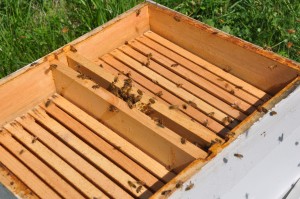
Just remember, if bees get directly into the syrup, they will drown. Keep the outer cover on securely to prevent them from going under it from outside the hive and getting into the syrup that way.
If you have entrance feeders, it’s all right to use them, but try them inside the empty box as I show above instead of using them at the hive entrance. You can check the hive as often as often as every day to make sure that the bees have an ample supply of syrup. Initially, give them about two quarts per hive, but adjust the amount as you see how quickly it disappears. I like to give them about a three day supply and replenish it with fresh syrup as needed.
You’re almost done!
Place the outer cover on top of the hive, putting a brick or rock on top. There will be some bees left in the shipping box, but don’t worry about them. Just lean the box against the front of the hive, and by dark they will find their way in. You have installed your first package of bees.
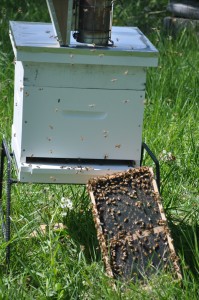
Come back in about three days
Wait three days, then check to see if the queen is out. If she is, just remove the now empty queen cage from between the frames . If you were only able to place 9 frames into the hive body with the queen cage, add the 10th frame. Make sure the frames are pushed together. Place the top back on the hive. My advise is not to go through the hive until one week after installation. Give them a chance to get used to the new hive.
I had a problem when I installed my new packages
Upon removing the queen cage from one of my packages, I discovered that the queen was dead. This happens sometimes (though it’s rare). What to do? I noticed that bees were clinging to the queen cage even though she was dead, so I went ahead and installed her as if she were alive – cage and all. I also installed the bees exactly as I would have if she had been alive. I have queens arriving in a few days to make nucs, so I plan to use one of them as a replacement. The bees will be fine, though the progress of this hive may be set back a few days. I’ll deal with that later. (Watch for future posts.) If I had not had queens arriving anyway, I would have called my supplier (Jim) and asked him to mail me a queen or made some arrangement to get a queen from him. A reputable supplier will replace a queen in this situation; you purchased a package with a live queen. This is a good lesson. In beekeeping, things often do not go as expected or as the book says they will. I always say, “Bees don’t read the books”. So we must adapt. Experience makes adapting easier, but part of becoming a beekeeper is gaining that experience.
One of the purposes of this series of posts is to attempt to give new beekeepers the benefit of my experience. So keep coming back, and feel free to ask questions. I will try to answer questions through the comment section in these posts.
Watch for the next post when Iwill report on removing the queen cages.

